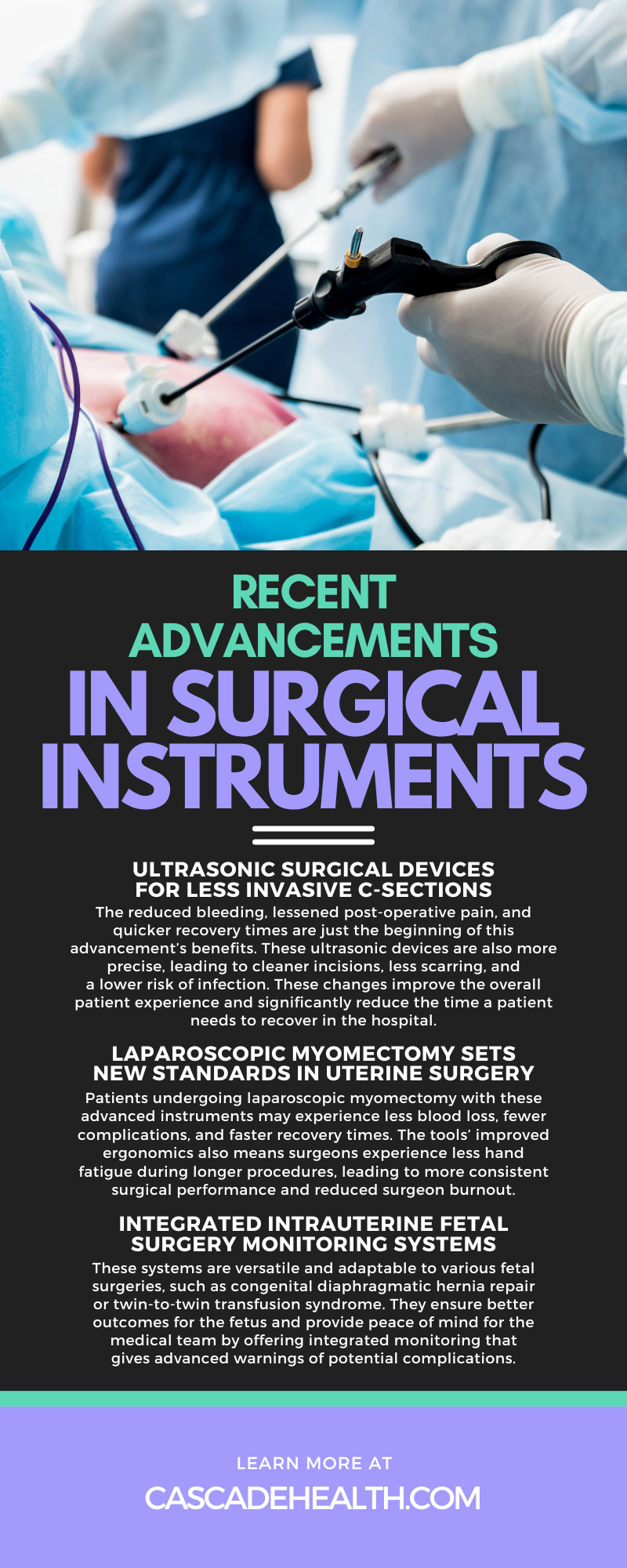8 Recent Advancements in Surgical Instruments
Surgical instruments, the silent heroes of modern medical procedures, have seen an incredible surge of innovation over the past few years. For midwives, obstetricians, and other medical professionals involved in surgical care, staying abreast of these advancements is a crucial part of improving patient outcomes and staying competitive in the field. Follow along as we explore eight recent advancements in surgical instruments specifically tailored to the unique challenges midwives and obstetricians face. Each advancement highlights the marvels of modern medical technology and celebrates the dedication to safe and effective patient care.
1. Ultrasonic Surgical Devices for Less Invasive C-Sections
The first advancement we’ll explore is the use of ultrasonic surgical devices in cesarean sections. Unlike traditional scalpels or electrocautery, ultrasonic devices, such as the Harmonic Scalpel, reduce the need for extensive cutting and tissue dissection. By using ultrasonic vibrations at frequencies higher than the human ear can detect, these devices can carefully cut tissue without leaving behind the damage that traditional methods might cause.
Benefits and Impact on Surgical Procedures
The reduced bleeding, lessened post-operative pain, and quicker recovery times are just the beginning of this advancement’s benefits. These ultrasonic devices are also more precise, leading to cleaner incisions, less scarring, and a lower risk of infection. These changes improve the overall patient experience and significantly reduce the time a patient needs to recover in the hospital.
2. Laparoscopic Myomectomy Sets New Standards in Uterine Surgery
Laparoscopic myomectomy, the surgical removal of uterine fibroids through small incisions, has seen a monumental stride with recent instrument advancements. The latest laparoscopic tools allow surgeons to manipulate uterine tissue with greater agility and precision.
How It Improves Patient Outcomes
Patients undergoing laparoscopic myomectomy with these advanced instruments may experience less blood loss, fewer complications, and faster recovery times. The tools’ improved ergonomics also means surgeons experience less hand fatigue during longer procedures, leading to more consistent surgical performance and reduced surgeon burnout.
3. Integrated Intrauterine Fetal Surgery Monitoring Systems
The third advancement is not just about surgical instruments but a complete system designed to monitor and enhance the safety of fetal surgeries. These integrated systems combine real-time imaging, diagnostic tools, and surgical platforms to give surgeons unparalleled control and visibility during complex intrauterine procedures.
Application in Different Surgical Specialties
These systems are versatile and adaptable to various fetal surgeries, such as congenital diaphragmatic hernia repair or twin-to-twin transfusion syndrome. They ensure better outcomes for the fetus and provide peace of mind for the medical team by offering integrated monitoring that gives advanced warnings of potential complications.
4. Smart Sutures and Surgical Tools
The evolution of smart technology has not left the field of midwifery untouched. Smart sutures, embedded with sensors and even microchips, have revolutionized wound care and tracking. Additionally, surgical tools with smart features such as vibration or color change now indicate proper usage or alert surgeons to potential issues.
How It Enhances Surgical Precision
Smart surgical instruments can help in many ways, from guiding surgeons along pre-planned incision paths to identifying the appropriate cut or tissue type depth during suturing. They are particularly beneficial in emergency obstetric cases where the surgeon may not be as experienced in a procedure.
5. Tissue Management Systems for Enhanced Efficiency
Managing surgical tissue has always been vital to the surgical process. Recent advancements in tissue management systems have streamlined this aspect of surgical care, improving efficiency and reducing the risk of post-operative complications.
Benefits for Medical Professionals and Patients
These systems offer better control over surgical environments, helping to maintain adequate visual fields and reduce the number of tissue-handling steps during a procedure. For patients, this means a reduction in the risk of infection and the potential for a quicker, more comfortable recovery.
6. Advanced Hemostasis and Ligation Techniques
Bleeding control and tissue sealing have seen significant enhancements with the introduction of advanced hemostasis and ligation techniques. Newer methods utilize energy sources such as radiofrequency, ultrasonic vibrations, or even surgical glues to seal tissue, offering non-invasive solutions to common surgical challenges.
Impact on Recovery Times and Post-Operative Care
These advancements can lead to shorter surgeries, reduced blood loss, and a lower need for transfusions. Faster recovery times translate to shorter hospital stays and lower healthcare costs for patients and providers alike.
7. Minimally Invasive Instruments for Neonatal and Pediatric Procedures
Surgical instruments designed specifically for neonatal and pediatric use have advanced greatly, and many options are in progress that would facilitate minimally invasive procedures. From tiny laparoscopic tools to specialized scopes, these instruments will suit the unique anatomical needs of the youngest patients.
Discussion of Safety Features and Risk Reduction
The smaller incisions required for these instruments lead to less scarring and reduced risk of post-operative infections. Additionally, many of these instruments have safety locks and ergonomic features that ensure the utmost care and precision during delicate procedures.
8. Robotics and AI in Obstetrics and Gynecology
Integrating robotics and artificial intelligence into surgical instruments in obstetrics and gynecology represents one of the most profound advancements, with robots working alongside human surgeons to enhance precision and control.
User-Friendliness and Training Requirements
Despite the sophisticated technology, these systems are increasingly user-friendly and can be quickly adapted by surgeons with adequate training. The implications for patient outcomes are immense, with these systems offering the potential for the most complex surgeries to be performed with greater precision and better results.
Paving the Way Forward in Midwifery and Obstetrics
The wave of innovation in surgical instruments is shaping the future of midwifery and obstetrics. Each of the advancements we’ve explored is a testament to the dedication of medical professionals and the relentless pursuit of safety and excellence in patient care.
The practice of midwifery and obstetrics is on the brink of a new era characterized by unprecedented precision, reduced invasiveness, and overall enhanced patient outcomes. Midwives and obstetricians are not just witnessing this change—they are leading the charge, one smart suture, hemostatic seal, and surgical robot at a time.
The call to action for the medical community is resounding. With this guide on advancements in surgical instruments, you can actively seek ways to integrate them into practice. If you’re looking for a medical equipment supplier, contact Cascade Health Care today. By doing so, midwives and obstetricians can ensure that they provide the best care possible, setting new benchmarks for the industry and ultimately contributing to a healthier and safer world.

Recent Posts
-
Exploring Recent Innovations in Doppler Signal Processing
Doppler technology has become an essential diagnostic tool in modern medicine, enabling healthcare p
-
Exploring Recent Innovations in Doppler Signal Processing
Doppler technology has become an essential diagnostic tool in modern medicine, enabling healthcare p


